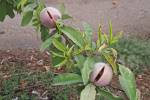Gardening in containers perfect for tight spots
If space is limited, but you still want to garden, try containers.
Live in a condominium? Grow plants in portable pots. Only have a patio? Cultivate flowers and/or vegetables in movable old dishpans. Yard all caliche? Raise veggies in raised beds or cement blocks. Live in a mobile home? Nurture nutritious foods in old whiskey barrels. A postage-stamp backyard? Use all the space through intensive (more plants per square foot) vegetable gardening. Have a blah front porch? Liven it up with a child's abandoned wagon full of nourishing veggies. Only have a veranda? Brighten it up with an abandoned toilet of posies and vegetables. You'll find nurseries loaded with many different sizes and shapes of plants and containers to consider.
Container gardening is the perfect answer for those with restrictive spaces. It has become popular in urban areas with limited spaces. More people are growing vegetables and flowers on roofs, especially in unusual containers. Standard-size vegetables adapt well to containers if watered, fed and given support, and plant breeders are coming up with more compact plants.
One big advantage of garden farming in containers is the small outlay of cash. Forget the rototiller or shed full of garden tools and bags of fertilizer to grow your plants. It is surprising what this method of "concentrated" gardening can produce, be it vegetables, herbs or fruit. It is all at your fingertips and just a dozen steps away.
And don't forget mobility. All plants need at least six hours of sun a day, so put containers on casters to track the sun or wheel them to your window when in bloom or at the peak of maturity to show off your accomplishments.
We often overlook the front entrance as a place to "plantscape." Place tomatoes, eggplants and peppers in some unusual containers. While they are growing, add a touch of color by including some petunias, marigolds or sweet alyssum at the front of the pot. The flowers will show off early but when this Solanaceae family of fine vegetables starts bearing gorgeous fruit, your visitors will be sampling them while waiting for you to answer the door.
Almost any vegetable lives comfortably in a container. Try carrots, beets, lettuce and onions in any available container that has a depth of 6 to 8 inches or more. I recall someone lining his patio wall with rows of cement blocks (8-by-8-by-16 inches) purchased at a brickyard planted with these crops. He filled blank spaces with potting soil and planted his seeds in them. You'll be surprised to see how well the plants grow.
Give careful attention to the shape of containers. If they are all the same size and shape, things will become monotonous and dull looking. Use your imagination as you put your containerscape together. I saw one ingenious gardener place a chair in the center of her arrangement. She planned on cultivating her plants every day, so her chair made it easier for her work and it became a focal point for friends to admire her little garden.
CARE OF CONTAINER PLANTS
Soil mix: Do not use your native soil, because it lacks organic matter, is high in salts and lacks nutrients. If that's not enough, it is heavy and might have soil-borne diseases and weed seeds. All nurseries and garden centers sell soil mixes in various sizes. You have complete control over the soil mix. In fact, mixes provide exactly what your plants need for success.
Drainage: A big must for growing plants in containers is good drainage. No vegetable, flower or fruit can take wet feet. If you overwater them and surplus moisture can't get away, plants suffocate. Regardless of what container you employ, make sure it has holes in bottom. And to prevent the soil mix from washing out, cover the holes with pieces of door screen. For containers that have solid bottoms sitting on cement, you need to prop containers up so water can exit.
Plant information: Examine the seed packet carefully before planting. Planting, spacing, feeding and other valuable information is written on seed packets. A container can sustain only a certain number of plants, therefore it is important to limit the number of plants based on the container size and the eventual size of the plant at maturity. Always plant more seed than needed in each container, because there is seldom 100 percent germination and emergence. After seeds sprout and develop leaves, thin plants to the desired spacing.
Watering: Once planted, watering becomes your chief task. Under our conditions, you have to become a religious irrigator, because soil in containers dries out quickly, especially on a hot day on concrete.
To check for moisture, insert your index finger to the second joint and feel. You want it slightly damp, not soggy. Observe your finger after removing it from the soil, because moist soil sticks to your finger. Also, smell it. To me, everything is OK if it smells like a fresh potato.
The best way to water is to have an irrigation specialist hook your plants up to a drip system, so watering won't become such a chore. There are systems to easily attach to your garden hose.
Here is a conservation tip: Place containers inside of a larger container and fill the space between them with organic matter to help keep the pot cool and slow evaporation.
Feeding: Because container plants are confined, feed them more often. Use a liquid plant food, making sure to follow the manufacturer's directions. If you prefer, use a slow-release plant food mixed with soil before planting. There also are organic fertilizer sources available at your nursery.
Since many gardeners are heavy-handed when applying fertilizer, apply fertilizer at half the label's recommendation and twice as often.
The key to success is choosing vegetables you enjoy eating. The real catch comes in finding time to spend on such a project.
LEARNING OPPORTUNITIES
Basics of fruit and veggies: How can I grow thriving, lush, juicy vegetables and fruit in this devastating heat? When is the best time to plant vegetables and fruit trees so we get the most out of them? My yard is nothing but a bed of caliche, is there any hope for turning my yard into a Garden of Eden? Answers to these and many other questions will help your garden produce high-quality veggies and fruit, and with a little planning, the results can last year-round. Join me at 2 p.m. Feb. 9 at the Springs Preserve, 333 S. Valley View Blvd. to learn more. For tickets and to reserve your seat, call 822-7786.
Linn Mills writes a garden column every Thursday. You can reach him at linn.mills @springspreserve.org or at the Gardens at the Springs Preserve 822-7754.























